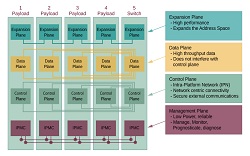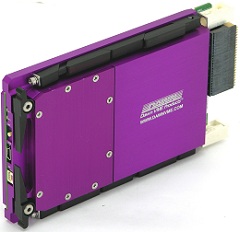For decades, the VME standard has defined an embedded computing architecture that was effectively deployed in mission-critical systems. But, as both processor technology and interprocessor communications evolved, bus-based VME could not keep pace and a new standard, OpenVPX, is now widely used for embedded systems with high performance requirements.
The OpenVPX embedded computing standard targets the needs of demanding defense and industrial applications. Established by the VITA Standards Organization and formally designated as ANSI/VITA 65.0, OpenVPX references other VITA standards to define a comprehensive systems architecture including mechanical specifications for modules, connector descriptions, thermal characteristics, communications protocols, utility, and power definitions. It also defines a multi-plane architecture approach for communication between system components, including support for several high bandwidth switch fabric protocols (figure 1).

Figure 1 – OpenVPX multiplane architecture approach for communication between system components.
OpenVPX uses a concept called 'profiles' to define choices for switch fabrics and other technologies. Components from different vendors that adhere to the same OpenVPX profile can be configured into functional systems. This characteristic of OpenVPX gives the benefits of interoperability, straight forward technical upgrades, and competition-driven cost containment.
Implementing OpenVPX solutions
While standardization delivers multiple economic benefits, mission-critical systems are usually pushing the design envelope in several dimensions. In the defense area, an example would be a computing system providing radar image processing on an unmanned aerial vehicle (UAV). This computing system must deliver real-time performance while staying within clearly defined size, weight and power (SWaP) constraints, and withstanding shock, vibration, and temperature extremes of a harsh environment.
System designers are challenged to meet these requirements while still adhering to the OpenVPX standard. A cookie cutter, one-size-fits-all approach is not going to work. Meeting the challenge requires an approach which uses innovative customization to configure systems comprised of OpenVPX-compliant components.
An OpenVPX backplane can be designed with the exact number of slots required for a specific application, then an enclosure designed around the backplane to create a customized chassis for a unique set of environmental parameters. The chassis can then be configured with OpenVPX modules selected from the open market.
Customization for mission-critical necessities
When the requirements are daunting, experienced-based innovation must drive this customization process. Discussed below are seven areas where OpenVPX innovation has been applied with very positive results.
Specialized materials : For systems where weight is a significant challenge, such as one deployed in a small UAV, specialized metals and alloys can be used to mold a lightweight chassis that stays within payload constraints and is also very rugged.
Cooling methods : For many embedded systems, air cooling is not an option and some form of conduction cooling is used. Designing a conduction cooled solution requires a systems level approach. Designers must consider not just how many watts of heat must be dissipated, but details such as where the internal heat sources are concentrated, and the heat transfer characteristics of all the system materials.
In some cases an 'air-over-conduction' approach is effective. This involves designing fins on the outside of a conduction cooled enclosure with an external fan moving air over these fins. Product engineers use thermal modeling software to analyze and modify heat dissipation, insuring operation within the required temperature range.
Customized backplanes : OpenVPX profiles allow designers to optimize the communication topology between slots within a system's backplane, delivering tremendous improvements in the performance of real-time applications. However, implementing a customized topology can be a complex and time consuming task. Specialized design tools, such as Dawn's Fabric Mapping Module (FMM) technology can simplify and automates this process. The tool uses a micro-overlay to interface a PCB based differential pair matrix with compatible backplanes, so inter-slot communications can be customized to meet unique system requirements.
There are a number of development systems available, like the Dawn DEV-4200 (figure 2), that help implement the flexible OpenVPX profile technology.

Figure 2 – Dawn DEV-4200 3U OpenVPX Development System.
Mechanical reinforcements/shock isolation : Platform and mission characteristics may require a system to be isolated from the platform with mechanical components that absorb shock and dampen vibration. The isolating components must be carefully modeled and designed for each implementation.
Electrical redundancies : The reliability of mission-critical systems can be enhanced through redundant power supplies. Depending upon the interplay of system requirements, the designer must trade off weight/space requirements and decide whether all or part of the systems should have this feature.
Sophisticated systems monitoring : Part of the OpenVPX multiplane architecture is the Management Plane, a sophisticated Intelligent Platform Management Interface (IPMI)-based infrastructure. IPMI communications are very flexible, allowing the construction of a consistent system management environment for alarms, configuration control, and diagnostics, running on a completely different medium from a system's data and control planes. While many OpenVPX systems make only limited use of this capability, it can be extremely effective during both the development and deployment of mission-critical systems to enhance reliability and to anticipate and understand system failures.
For example, power supplies can have integrated monitoring for temperature at multiple points, including each wedge lock. In an air cooled system, this information can be used to determine if the fans are working properly and any filters are in need of cleaning.
Full system monitoring can be performed by small external devices using an Ethernet link to a chassis for tracking and controlling voltages, current and temperatures. Fan speeds can be controlled by user commands or temperature targets. System monitoring is also useful during the system development phase.

Figure 3 – The Dawn ITM-6973 3U OpenVPX Intelligent Test Module.
System design validation and characterization : Intelligent test modules (figure 3) can perform a range of applications and tests, such as OpenVPX rule compliance testing and certification, system design validation and characterization. While most applications cannot devote a system slot to monitoring, these modules can be used as a monitoring, data logging and reporting device when included within deployed systems. During deployment, extraordinary events can be data logged and time stamped, such as shock and vibration levels outside of normal thresholds.
Advertisement
Learn more about Dawn VME Products





